As Iran continues to absorb blows from Israel’s attacks on it’s nuclear and military infrastructure, there is growing commentary to suggest disaffected Iranians could topple their unpopular and despotic government.
A 2022 survey showed just how unpopular the current government with Iran really is. The survey showed that more than 80 percent of respondents reject the Islamic Republic and prefer a democratic government.
The Netherlands-based Gamaan Institute asked “In response to the question “Islamic Republic: Yes or No?” 81% of respondents inside the country responded “No” to the Islamic Republic, 15% responded “Yes,” and 4% were not sure.
While Iran’s theocratic government appears to be quite vulnerable following Israel’s attacks, they have been very effective over the years since the Iranian Revolution in 1979, in quashing dissent and instilling fear in its people.
Israeli Prime Minister Benjamin Netanyahu is using this opportunity and telling the Iranian people that Israel’s attack can help them saying “This is your opportunity to stand up.”
The Iranian people have certainly tried. There have been three significant uprisings within Iran in the last fifteen years: the 2009 Green Movement to protest massive fraud in presidential elections; the 2019 uprising over rising egg and gasoline prices, and in 2022 with the “Women, Life, Freedom” protests which followed the death of Mahsa Amini.
Amini was arrested by Iran’s morality police for allegedly not wearing the hijab in accordance with government standards and was sent to a detention facility for “re-education.” Amini suffered multiple blows to the head before she died, according to London-based broadcaster Iran International.
Iran’s theocratic regime has racked up egregious human rights violations by restricting the freedoms of assembly and expression and routinely arresting and killing those who protest.
An archived content posting on the U.S. State Department website from President Donald Trump’s first administration stated: “The United States supports the Iranian people’s struggle for human rights, democracy, and freedom. The regime’s greatest victims are the Iranian people. Regime elites squander the people’s resources and opportunities, while suppressing freedom and basic human rights.”
Human Rights Watch (HRW) reports that Iran remains one of the world’s top practitioners of the death penalty, applying it to individuals convicted of crimes committed as children and under vague national security charges; occasionally, it is also used for non-violent offenses.
In 2024, the United Nations (UN) Human Rights Council reported that Iran was responsible for the “physical violence” that led to the death of Amini and their Fact-Finding Mission on Iran that concluded Tehran committed “crimes against humanity” through its actions.
It also found that the Islamic Republic employed “unnecessary and disproportionate use of lethal force” to put down the demonstrations that erupted following Amini’s death and that Iranian security forces sexually assaulted detainees.
The crackdown in 2022-2023 killed more than 500 people and saw over 22,000 detained.
After analyzing protest deaths and eye injuries, Iran Human Rights (IHR) revealed that women’s eyes and faces were intentionally targeted during the 2022 protests.
The Human Rights Center at UC Berkeley verified that roughly 120 people, most aged 30 and under, lost some or all of their sight when Iranian security agents fired shotguns, paintball guns and even tear gas canisters. Center investigators stop short of saying that security forces broadly intended to blind the protesters.
It remains to be seen if the conflict between Israel and Iran will be the catalyst for a successful uprising in Iran. But history tells us that when the oppressive Iranian regime is threatened, they are ruthless in their retaliation of their own people.
Related
Lynn Schmidt
Lynn Schmidt holds a bachelor of science in nursing from the University of North Carolina at Greensboro and a masters of science majoring in political science from the University of Nebraska-Omaha. She is a freelance columnist and editorial board member with the St. Louis Post-Dispatch and a monthly contributor to The Fulcrum. Lynn lives in St. Charles, Missouri with her husband and two daughters.




